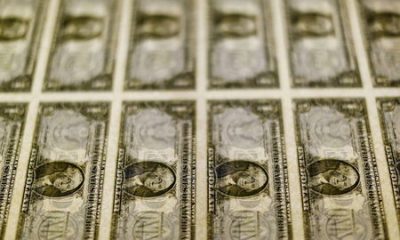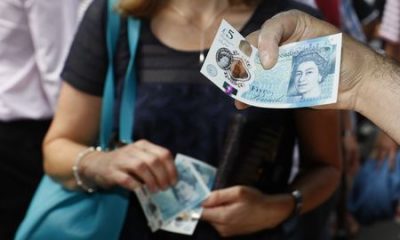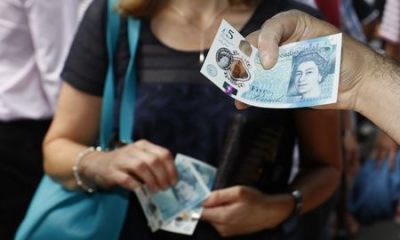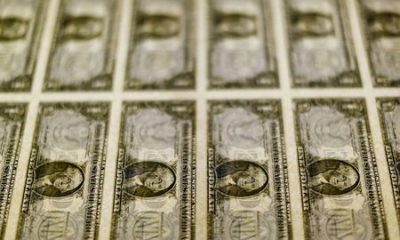Forex
Dollar jumps to one-month high as rate-cut bets fall
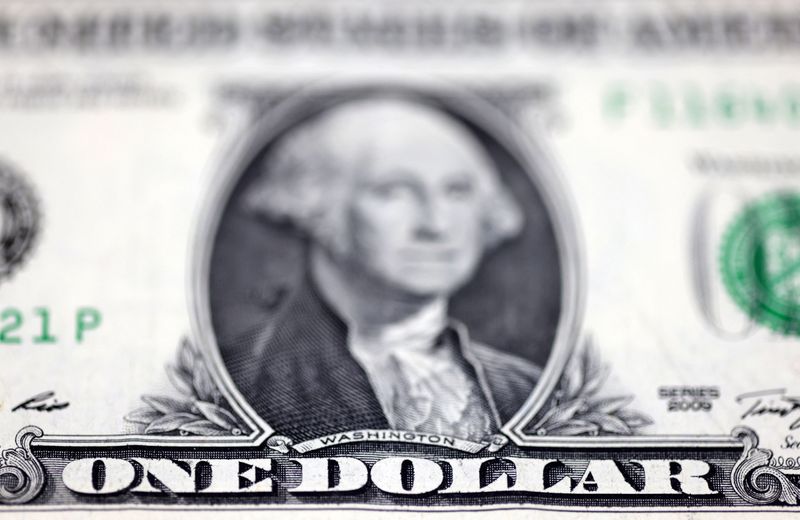
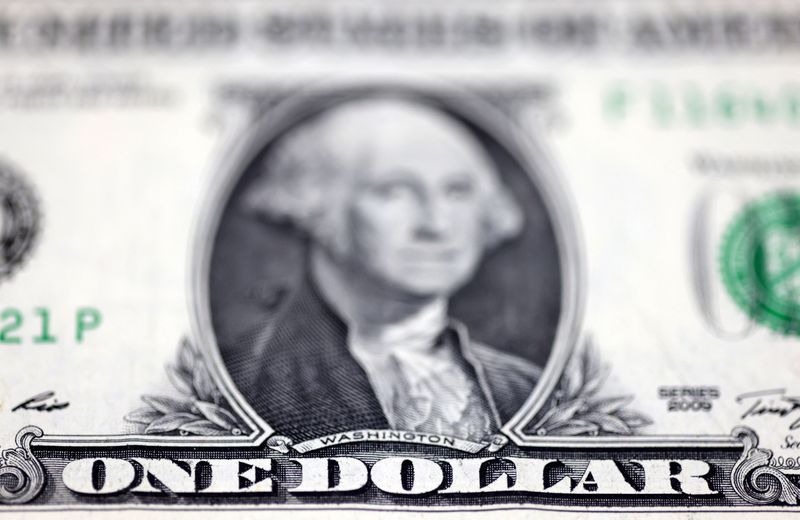
© Reuters. U.S. Dollar banknote is seen in this illustration taken July 17, 2022. REUTERS/Dado Ruvic/Illustration/File Photo
By Harry Robertson and Ankur Banerjee
LONDON/SINGAPORE (Reuters) -The dollar rallied on Tuesday as investors tempered their expectations for a March rate cut from the Federal Reserve, while the pound and yen dropped as inflationary pressures subsided.
Against a basket of currencies, the dollar rose 0.51%to 103.16, around a one-month high. It gained 0.2% overnight in subdued trading during a U.S. public holiday on Monday.
The euro fell 0.54% to $1.0892, set for its steepest one-day percentage drop in two weeks.
Comments from European Central Bank officials downplaying the idea of early rate cuts overshadowed the outlook for borrowing costs globally.
The ECB’s Joachim Nagel on Monday said it was too early to talk about cuts, and his Austrian colleague Robert Holzmann said markets should not bank on borrowing costs falling this year. Other policymakers on Tuesday maintained a cloud of uncertainty over the timing of the moves.
“The hawkish ECB commentaries last night have fuelled concerns that market pricing for the Fed rate path may also be aggressive,” said Charu Chanana, head of currency strategy at Saxo in Singapore.
“Some safe-haven demand also likely to be at play with Red Sea disruptions escalating.”
U.S. bond yields rose on Tuesday after Monday’s holiday, with the 10-year up 6 basis points at 4.011%, supporting the dollar.
Jane Foley, head of FX strategy at Rabobank, said a bleak outlook for Germany’s economy, which shrank 0.3% last year, was likely another factor weighing on the euro.
“With budget cuts coming, it doesn’t look good for the German economy in terms of growth for the year ahead,” she said.
ECB data on Tuesday showed consumer expectations of euro zone inflation three years ahead fell sharply in a November poll to 2.2%, from 2.5%.
STERLING AND YEN FALL
Sterling was last down 0.71% at $1.2637 after data showed British wage growth slowed sharply in the three months through November, supporting the idea that the Bank of England will cut rates heavily this year.
The dollar was 0.58% higher against the Japanese yen, at 146.65 yen to the dollar, around a five-week high. The yen fell after figures showed Japan’s wholesale price index stayed flat in December from a year ago, with the rate of change slowing for the 12th straight month.
The Australian dollar, which tends to fall when investors are worried about taking on risk in the market, was down 0.87% at $0.6603.
Investors awaited comments later on Tuesday from the Fed’s Christopher Waller, whose dovish turn in late November helped to trigger a blistering year-end market rally.
Markets are pricing in a 69% chance of a 25 bp cut in March from the Fed, versus 77% a day earlier and 63% a week earlier, the CME FedWatch Tool showed. Traders expect cuts of roughly 160 bps this year.
Investors were also monitoring news from the Red Sea. An official from the Iran-aligned Houthi movement said on Monday the group will expand its targets to include U.S. ships, and would maintain attacks after U.S. and British strikes on its sites in Yemen.
In Iowa, Donald Trump asserted his command over the Republican party with a resounding win on Monday in the first 2023 presidential contest for the party.
Rabobank’s Foley said the result could be weighing on the euro “at the margin” as investors begin to think about what a more isolationist America under a potential Trump presidency might mean for Europe.
Forex
Asia FX weakens as dollar recovers amid waning rate cut cheer
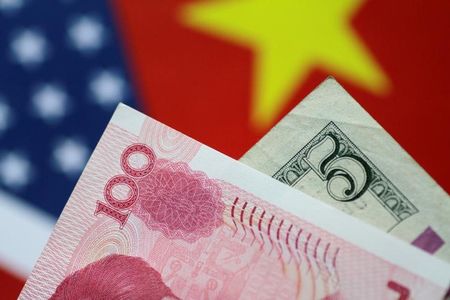
Investing.com– Most Asian currencies retreated on Friday as the dollar recovered a measure of recent losses after a string of Federal Reserve officials warned that bets on interest rate cuts may be premature.
While the greenback was still headed for some weekly losses, it was trading well above a one-month low hit on Thursday. U.S. Treasury yields also rebounded, pressuring risk-driven markets.
Regional factors also weighed on Asian currencies, as economic data from China and Japan underwhelmed.
Chinese yuan weak amid mixed economic prints
The Chinese yuan’s pair rose 0.1%, moving back to six-month highs above 7.22.
Economic readings from the country continued to offer middling signals on an economic recovery. Data on Friday showed grew more than expected in April.
But other readings showed growth in slowed sharply, while a decline in Chinese accelerated last month.
Chinese also grew less than expected in April, while fell from a seven-month high, but still remained relatively high.
The readings presented a mixed outlook for Asia’s biggest economy. They also came after the U.S. imposed higher tariffs on key Chinese industries, sparking fears of a reignited trade war between Beijing and Washington.
Concerns over China weighed on other currencies with trade exposure to the country. The Australian dollar’s pair fell 0.2%, while the South Korean won’s pair rose 0.7%.
The Singapore dollar’s pair rose 0.1% after the island state’s grew at a slower-than-expected pace in April, and also contracted sharply from last year.
remove ads
.
Weakness in the Japanese yen deepened after weaker-than-expected gross domestic product data for the first quarter. The pair rose 0.3% and was close to breaking above 156, extending sharp overnight gains.
Dollar recoups most weekly losses as Fed downplays rate cuts
The and rose 0.2% each in Asian trade, extending an overnight rebound from one-month lows.
The dollar’s recovery came as several Fed officials, specifically members of the bank’s rate-setting committee, said that they needed much more confidence that inflation was coming down, beyond some easing inflation in April.
This saw traders scale back bets on a September rate cut, albeit slightly, according to the .
Still, the dollar was set to lose about 0.7% this week, following some softer-than-expected data for April. The reading, coupled with soft data pushed up hopes that inflation will cool in the coming months.
Forex
Dollar steadies, but on track for sharp weekly loss
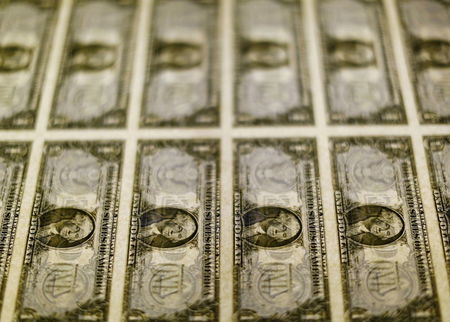
Investing.com – The U.S. dollar edged higher in European trade Friday, but was on track for a hefty weekly fall after cooling inflation and weak retail sales brought Federal Reserve rate cuts back into focus.
At 04:10 ET (08:10 GMT), the Dollar Index, which tracks the greenback against a basket of six other currencies, traded 0.2% higher at 104.580, marginally above a five-week low just below 104 seen earlier this week.
Dollar steadies after hawkish Fed speak
The dollar has recovered to a degree as several Fed officials, specifically members of the bank’s rate-setting committee, said that they needed much more confidence that inflation was coming down, beyond some easing inflation in April.
“I now believe that it will take longer to reach our 2% goal than I previously thought,” St. Louis Federal Reserve president Loretta Mester said on Thursday, adding that further monitoring of incoming data will be needed.
Federal Reserve Bank of New York President John Williams agreed with this view.
“I don’t see any indicators now telling me … there’s a reason to change the stance of monetary policy now, and I don’t expect that, I don’t expect to get that greater confidence that we need to see on inflation progress towards a 2% goal in the very near term,” Williams said.
However, the dollar is still on course for a weekly loss of around 0.7% after the milder than expected U.S. data raised expectations the will deliver two interest rate cuts this year, probably starting in September.
remove ads
.
U.S. were also flat in April and softer-than-expected, and manufacturing output unexpectedly fell.
“Our view for the near term remains that we could see a further stabilisation in USD crosses as markets await the next key data input: April core PCE on 31 May,” said analysts at ING, in a note.
Euro slips ahead of CPI release
In Europe, traded 0.1% lower to 1.0860, having traded as high as 1.0895 in the wake of U.S. inflation release, but the single currency is still up around 0.9% on the dollar this week.
The final reading of the is due later in the session, and is expected to show inflation rose by 2.4% on an annual basis in April.
The is widely expected to cut interest rates in June, but traders remain unsure of how many more cuts, if any, the central bank will agree to over the course of the rest of the year.
Traders have priced in 70 basis points of ECB cuts this year – a lot more than the just under 50 bps of easing priced in for the Fed.
fell 0.1% to 1.2658, but is still on track for gains of around 1% this week.
The Bank of England is also expected to cut rates from a 16-year high this summer, but volatility is likely to be limited ahead of the release of key U.K. inflation figures next week.
Yen slips after weak Japanese GDP data
In Asia, rose 0.3% to 155.87, close to breaking above 156, after weaker-than-expected Japanese data for the first quarter.
remove ads
.
traded 0.1% higher at 7.2209, moving back to six-month highs above 7.22 after data earlier Friday showed grew more than expected in April, but growth in slowed sharply, while a decline in Chinese house prices accelerated last month.
Forex
ING anticipates EUR/GBP rise as BoE rate cut bets increase

Broker ING noted the potential downside risks for the British pound, noting the currency’s recent decline from its peak against the euro. The GBP’s sensitivity to the performance of US equities was highlighted as a contributing factor to its movement.
The firm also observed a decrease in volatility for the pair as the market anticipates the release of key Consumer Price Index (CPI) figures in the UK scheduled for next week.
ING’s UK economist suggests that there may be a dovish tilt in expectations for the Bank of England’s (BoE) monetary policy. The firm maintains a favorable outlook on the possibility of the EUR/GBP pair rising, as market participants might increase their wagers on a potential interest rate cut by the BoE in June.
The British financial markets were focused on a speech delivered by Catherine Mann of the BoE, who is regarded as the most hawkish member of the Monetary Policy Committee (MPC).
This event followed comments made by Megan Greene, who recently shared a cautiously optimistic perspective on inflation, mirroring sentiments expressed by BoE Governor Andrew Bailey at the last meeting.
ING’s commentary comes as investors and analysts closely watch the central bank’s moves, which could significantly influence currency valuations. The anticipation of UK CPI data and the BoE’s potential response are key factors in the firm’s analysis of the GBP’s trajectory.
This article was generated with the support of AI and reviewed by an editor. For more information see our T&C.

 Forex2 years ago
Forex2 years agoForex Today: the dollar is gaining strength amid gloomy sentiment at the start of the Fed’s week

 Forex2 years ago
Forex2 years agoHow is the Australian dollar doing today?

 Forex1 year ago
Forex1 year agoUnbiased review of Pocket Option broker

 Forex2 years ago
Forex2 years agoDollar to pound sterling exchange rate today: Pound plummeted to its lowest since 1985

 Cryptocurrency2 years ago
Cryptocurrency2 years agoWhat happened in the crypto market – current events today

 World2 years ago
World2 years agoWhy are modern video games an art form?

 Stock Markets2 years ago
Stock Markets2 years agoMorgan Stanley: bear market rally to continue

 Economy2 years ago
Economy2 years agoCrude oil tankers double in price due to EU anti-Russian sanctions



